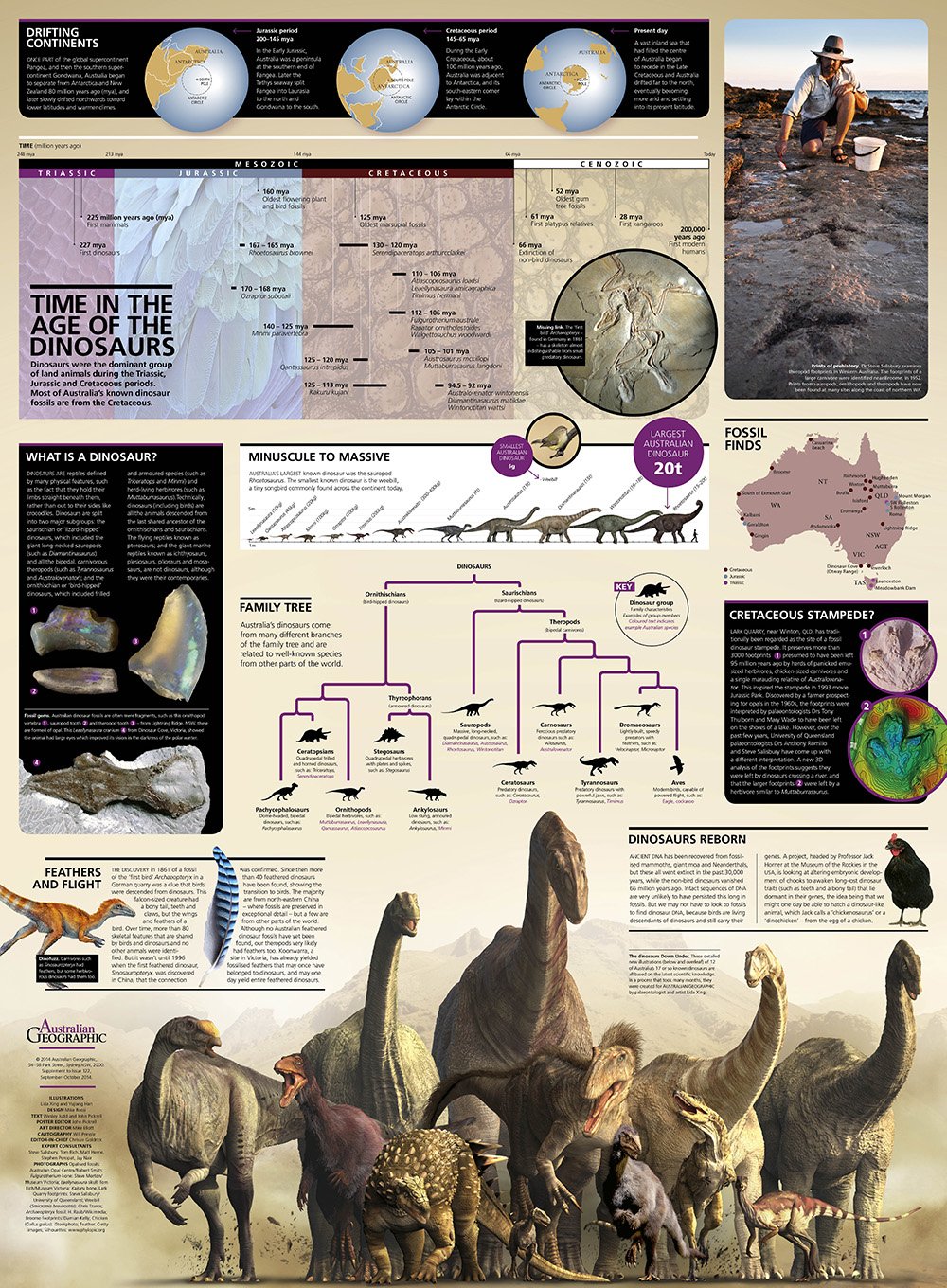Illustrating the dinosaurs of Australia

John Pickrell
John Pickrell

IN THE LATEST issue of Australian Geographic (Sep/Oct, AG 122), subscribers received an incredible poster featuring brand new illustrations of 12 of Australia’s 17 or so known species of dinosaur.
Created by Beijing-based palaeontologist and illustrator, Lida Xing, these are some of the most detailed reconstructions ever attempted for Australian dinosaurs, and they are based on the most up-to-date evidence from the fossil record.
Lida’s team built them from scratch, using information from the fossils and sophisticated computer software. They sought information from Australian scientists and had their designs checked and re-checked along the way.
If you missed out on the poster with the current issue, you can order one here. To make sure you don’t miss out on the fantastic maps, posters and other gifts that are free to subscribers with many issues of AG, subscribe here.
To learn a bit more about the process of creating the illustrations, I spoke to Lida in Beijing and asked him to tell us what went into the reconstructions. Find the full images of the poster below.
What method did you use?
Lida Xing: Making an outline based on the fossils is the first step. Following this, muscle, skin and feathers are added. The next step is drawing it with a computer, or with 3D software. Starting this year, really the majority of our illustrations have been created with 3D software, which allows us to create very delicate detail with skin, scales and feathers. We sometimes even print out models of the dinosaurs with a 3D printer, which helps us to finely adjust their posture.
How do you make sure your illustrations are accurate?
LX: It’s difficult because, for most species, the fossil records are incomplete. I prefer to collaborate with scientists who are experts on each species, taking in their advice on our designs. When I am illustrating dinosaurs from China’s northeastern province of Liaoning [where many of the feathered dinosaurs are from], I frequently visit eminent expert Professor Xu Xing, based at the Institute of Vertebrate Paleontology and Paleoanthropology in Beijing. With the Australian dinosaurs for the poster we sought advice from scientists such as Dr Tom Herne and Professor Steve Salisbury at the University of Queensland, and Dr Tom Rich at Museum Victoria.
Do you refer to fossils?
LX: Yes, this is essential. As my tutor Professor Phil Currie [at the University of Alberta, Canada] says, “fossils tell you everything”. With the Chinese species from Liaoning the volcanic ash deposits preserve many details perfectly, which is very helpful to our work. When you have incomplete fossils and few specimens – as with most of the Australian dinosaurs – the best you can do is approximate how they would have looked based on the specimens of closely related species.
How do you decide whether or not to include feathers?
LX: Many people dislike the new illustrations of dinosaurs with feathers, as they think it makes them look like big chickens! However, the science does suggest that many carnivorous dinosaurs and even some herbivores were feathered, therefore, when we create illustrations we check to see if the fossils have any feather impressions, or if related species of dinosaurs are known to have had feathers.
Is there a lot of art as well as science in these reconstructions?
LX: Good question. Traditionally, I think there was more art than science in these reconstructions. The information from fossils can be very limited, but as more and more exquisite fossils having been found and studied, we have accumulated good knowledge of some species. For example, with Microraptor (a four-winged gliding dinosaur from Liaoning) thousands of individual fossils have revealed detailed information about its skeleton, body size, diet, feather colour and feather shape. Therefore, I dare to say, so long as we stay within the given information, the reconstructions we make are more ‘scientific’ than ‘artistic’. We call it ‘accurate reconstruction’, which is what we always hope to achieve. With the Australian species it is more difficult as the fossils are so incomplete, but we do our best to create accurate reconstructions.


John Pickrell is the author of Flying Dinosaurs: How fearsome reptiles became birds, published by NewSouth Books in June 2014. Follow him on Twitter @john_pickrell.




